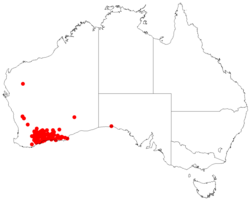Biology:Leucopogon cuneifolius
| Leucopogon cuneifolius | |
|---|---|

| |
| Scientific classification Error creating thumbnail: Unable to save thumbnail to destination
| |
| Kingdom: | Plantae |
| Clade: | Tracheophytes |
| Clade: | Angiosperms |
| Clade: | Eudicots |
| Clade: | Asterids |
| Order: | Ericales |
| Family: | Ericaceae |
| Genus: | Leucopogon |
| Species: | L. cuneifolius
|
| Binomial name | |
| Leucopogon cuneifolius Stschegl.[1]
| |

| |
| Occurrence data from AVH | |
| Synonyms[1] | |
| |
Leucopogon cuneifolius is a species of flowering plant in the heath family Ericaceae and is endemic to Western Australia. It is an erect, bushy shrub that typically grows to a height of 0.2–1.5 m (7.9 in–4 ft 11.1 in). Its leaves are egg-shaped to lance-shaped with the narrower end towards the base, about 6 mm (0.24 in) long with a distinct petiole. Up to 3 flowers are borne in upper leaf axils on a short peduncle, with small bracts and bracteoles at the base. The sepals are about 3 mm (0.12 in) long and the petals about 5 mm (0.20 in) long, the petal lobes much shorter than the petal tube.[2]
This species was first formally described in 1859 by Sergei Sergeyevich Sheglejev in the Bulletin de la Société impériale des naturalistes de Moscou.[3][4] The specific epithet (cuneifolius) means "wedge-leaved".[5]
Leucopogon cuneifolius (as Styphelia lissanthoides) occurs in the Avon Wheatbelt, Coolgardie, Esperance Plains and Mallee bioregions of south-western Western Australia and is listed "not threatened" by the Government of Western Australia Department of Biodiversity, Conservation and Attractions.[6]
References
- ↑ 1.0 1.1 "Leucopogon cuneifolius". https://biodiversity.org.au/nsl/services/apc-format/display/98674. Retrieved 21 July 2022.
- ↑ Bentham, George; von Mueller, Ferdinand (1868). Flora Australiensis. 4. London: Lovell Reeve & Co.. p. 219. https://www.biodiversitylibrary.org/page/11266440#page/228/mode/1up. Retrieved 21 July 2022.
- ↑ "Leucopogon cuneifolius". APNI. https://id.biodiversity.org.au/instance/apni/524812.
- ↑ Sheglejev, Sergei Sergeyevich (1859). "Epacridearum Novarum". Bulletin de la Société impériale des naturalistes de Moscou 32 (1): 18. https://www.biodiversitylibrary.org/item/151383#page/22/mode/1up. Retrieved 21 July 2022.
- ↑ Sharr, Francis Aubi; George, Alex (2019). Western Australian Plant Names and Their Meanings (3rd ed.). Kardinya, WA: Four Gables Press. p. 175. ISBN 9780958034180.
- ↑ "Styphelia lissanthoides". FloraBase. Western Australian Government Department of Parks and Wildlife. https://florabase.dpaw.wa.gov.au/browse/profile/49810.
Wikidata ☰ {{{from}}} entry
 |

